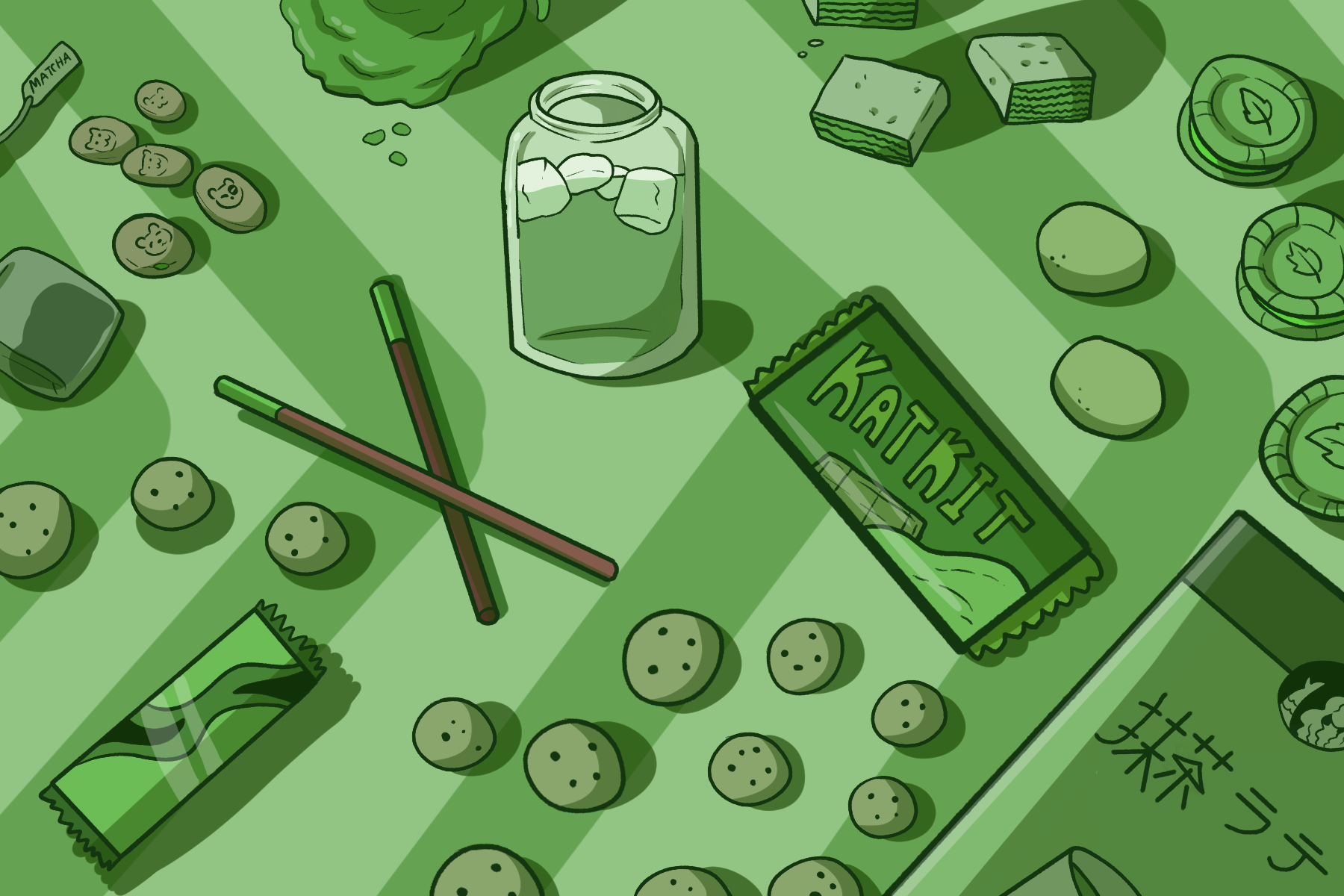In 2015, Goop founder Gwyneth Paltrow made an Instagram post promoting her “new dreamy discovery,” the matcha latte — and she was only a thousand years late to the game. Made of powdered green tea leaves, it has been a staple of the East Asian diet since the 10th century C.E., originating in China but having its culinary technique developed further in Japan. Centuries later, Paltrow’s post has kickstarted a rise in matcha’s popularity. It has been firmly adopted by the Western world, only for Americans to overlook its complex flavor and health benefits in favor of commodification.
Origins and Cultural Significance
Matcha dates back to the Tang Dynasty (618-907 C.E.) in China when the most efficient way to transport green tea was in the form of bricks. The bricks were made of a rudimentary matcha powder; these steamed, dried and pulverized leaves were easier to carry long distances than loose ones. When it was introduced to Japan by a Zen Buddhist monk (Myoan Eisai), the process of its creation took on new complexities. “The way of tea” (chadō) developed, a system to honor matcha to the fullest extent. The leaves were highly select; only the leaves of young, shade-grown plants taken from the top three layers of the tree were used in its creation. The sacred ceremony of whisking the powder into hot water often was a multi-hour process, designed to enhance the appreciation of the vegetal, nutty flavor and encourage a calmness and peace of mind. Practitioners of chadō would eventually develop the four basic principles of the way of tea: harmony, respect, purity and tranquility.
Buddhist monks in Japan noted the heightened sense of focus and calm that emerged after drinking the tea, which aided in meditation and the pursuit of enlightenment. For this reason, it became intertwined with spirituality in Japan, within the Buddhist community and also, after percolation, within the general population. Today, it is known that matcha contains L-theanine, an amino acid that enhances mental stillness and reduces anxiety. The L-theanine, alongside antioxidants and moderate levels of caffeine, has made the tea invaluable to the Japanese people for a millennium.
Matcha in America
Returning to the twentieth century, it becomes clear that American attitudes toward matcha starkly differ from Japanese attitudes. Having adopted this tea centuries after its creation, Americans have limited knowledge of its significance on a spiritual and cultural level, preferring to enjoy it passively in lattes, milkshakes, desserts and even guacamole. While there do exist certain matcha-flavored foods in Japan, such as cha soba (buckwheat noodles) and cha dango (sweet rice dumplings), American corporations created matcha desserts and beverages overwrought with sugar, flavorings and other additives. Matcha has been made an ornamentary addition to food, and the nuanced flavor gets lost in translation. Anybody who’s tasted Starbucks’ Shamrock Shake can attest to this.
The lived experiences of Japanese-Americans offer a fresh perspective on the discourse. One student commented that matcha’s dissemination is not all bad, but expressed concern that “[The tea ceremony] could potentially be disassociated with it.” Starbucks and their matcha frappuccinos are certainly a departure from chadō and its four pillars. Likely few Americans have an understanding of what matcha means historically, and even fewer have practical experience with the way of tea.
An interview conducted by a tea student supplants another perspective, in which the sensei, Suchi Takahara, expresses gladness at matcha’s rising popularity, as its benefits should not be reserved only for the Japanese people. However, she recounts a conversation with an importer of the drink into the United States, in which he called chadō “boring” and “meaningless.” To this, Takahara said, “I felt so sorry for him because he never had the opportunity to learn about chadō.” In the changing of matcha in America, consumers not only do a disservice to Japanese culture but to themselves.
In addition to altering the method of consumption, American corporations appeal to their target audience by projecting their own interests onto matcha powder. Historically, its real merit was in its ability to promote mental clarity, a stepping stone to enlightenment. In the West, the weight loss properties take center stage as its main selling point; it is revered for its effects on appetite, metabolism and energy levels. The physical improvements observed in regular matcha drinkers are seen through the myopic lens of physical appearance, as opposed to holistic wellbeing. While matcha does possess certain weight loss properties, the weight loss is simply a byproduct of the overarching health benefits, like its anticarcinogenic and liver protective properties.
Matcha’s cultural proliferation does not stop at cuisine, as American consumers flock to buy matcha-infused skincare. Various face masks, concealers and serums with it as a star ingredient have populated the market for the past few years, despite dubious claims to the health benefits topical it provides. On TikTok, the hashtag #greenteamaskstick has amassed 7.8 million views and the misspelled #greeteamaskstick 22.1 million. Although it does provide a soothing anti-inflammatory effect, matcha does not perform miracles on the skin. Experts on skincare assert that topical matcha can be beneficial, but that studies thus far have insufficient data to make any solid claims on that front.
“But I Like Matcha Lattes?”
The argument for maintaining matcha’s traditional form does present a dilemma. There remains the fact that Americanized matcha foods can be delicious, regardless of their differences from plain matcha tea. When the flavor is allowed precedence and treated with respect, even historically un-Japanese foods can adopt matcha and create something unique and thought-provoking. Matcha opera cake, macarons, pudding; when done well, these foods preserve matcha’s dignity while introducing it to a cuisine previously unexplored. Consuming a matcha frappe does not make a person inherently dismissive of Japanese culture. Using a matcha face mask does not mean disrespecting a thousand years of tradition. However, it remains necessary to bear in mind the import of matcha on a cultural level, even while American corporations present matcha products largely disconnected from their roots. As with the introduction of any other culture’s food into the mainstream American awareness, it is imperative that consumers acknowledge matcha as something to be treated with dignity and respect.
















